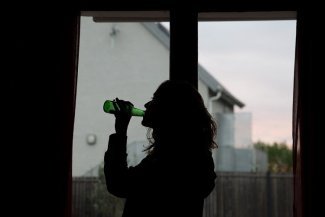Belgian singer-songwriter Stromae recently unveiled his song and video clip L’enfer (Hell), which deals openly with depression and suicidal thoughts.
“Sorry, I have anxiety, I’m going to do the best I can.” With these words, Irene López Caballero, better known as Poochyeeh, begins her concerts with the group Sweet Barrio. “The first few times I was afraid of people’s reactions. Then I realised that everyone was applauding me,” the 30-year-old Spanish singer tells Equal Times. Talking about her anxiety in public was long a taboo subject for her. The pandemic sped up changes that were already taking place, particularly among younger people. Saying “I feel sad,” “I suffer from anxiety” or “I am depressed” out loud has become normalised.
“It’s no longer a crime to say that you have problems related to mental health, it doesn’t sound strange anymore. It’s something normal that we all experience at some point in life,” says Caballero. She has suffered from a severe panic disorder since she was a teenager and began seeing a therapist at the age of 15. “You have to go to a therapist whenever you need to, it’s about giving yourself time.”
She believes that it is important for artists to express such feelings in their work and put an end to the cliche that famous people are perfect and don’t suffer. “On the contrary, as artists we are vulnerable and emotionally exposed. We typically hide our weaknesses but I prefer to be honest. If by using my platform, however small it may be, just four people identify with what I’m going through and are able to put a name to what they feel, then I’ve already achieved a lot.”
It took her some time to come to this conclusion. In her quest to better understand herself, she read, listened to professionals and followed the examples of other artists. “I wouldn’t have the courage to get on stage if it weren’t for the free women who came before me – Janis Joplin, Buika, Betty Davis and Amy Winehouse – women who were proud to live on the fringes of the socially acceptable.”
Poochyeeh conducted an experiment: she invited her close circle of friends, including other artists, to open up about their problems on her podcast Las Mujeres Son De Azúcar for Gladys Palmera in a special episode on mental health. Not a single man responded to her request. “I was shocked. Are you telling me men don’t suffer too?” asks the singer.
Much in the same way that it’s difficult to find a footballer who will admit to being gay, she believes that it’s still rare for men to talk about their mental health. “Women suffer under a lot of pressure in this society, but men have a major problem too: they haven’t been taught to express their emotions. There’s still this false perception that it’s a bad thing,” psychologist Esther Sánchez tells Equal Times.
But not all men are afraid to express their emotions. One exception is Belgian singer-songwriter Stromae, whose new release L’enfer (Hell) deals with his suicidal thoughts. The song, along with a recent interview he gave to French TV station TF1, have won him praise from mental health professionals and even from the director-general of the World Health Organization. In the United States, Saturday Night Live comedian Peter Davidson and US cultural icon Kanye West have also spoken openly about their mental health struggles.
The pandemic within the pandemic
After more than three years writing songs with Sweet Barrio, a group from the outskirts of Madrid that fuses pop and flamenco rhythms, Poochyeeh had yet to address the subject of anxiety in her lyrics. Her first song dealing with the topic will be released soon for a new project. “I wasn’t ready before. I thought it was a minor problem, that it was my fault and didn’t deserve anyone else’s attention. This is going to sound strange but the pandemic has given me the courage. I’m not going to hide it anymore.”
Like her, many other artists around the world are shining a light on what has already been dubbed ‘the pandemic within the pandemic’. “It’s still too early to analyse the mental health consequences of what we have experienced over the last two years, especially among directly affected groups such as health workers, as post-traumatic stress syndrome can appear up to 12 months later,” explains Sánchez.
Artists have begun to respond to the anxiety, depression and fear that many have faced.
“Deja de decir que no puedes más, que no puedes más, porque no es cierto / Deja de vivir en esta soledad, en esta soledad, que está en tu cuerpo” (Stop saying that you can’t go on, because it’s not true / Stop living in this solitude, which is in your body), sings the Colombian band Bomba Estéreo on their new album Deja, in which they reflect on mental health. “Our music proposes a spiritual connection with that which surrounds us through empathy, self-love and inner peace,” explains singer Li Saumet.
Zoe Gotusso, born in Córdoba (Argentina) in 1997, released her debut solo album Mi Primer Día Triste (My First Sad Day) in 2020, an unflinching pop-portrait of the loneliness and sadness (amplified by the lack of a stable future, job insecurity, difficulty in emancipating oneself and forming a family, the constant global crises) experienced by Generation Z, those born around the turn of the century. “I feel it’s good to express these things in public, to make them visible, to show that being sad is not a bad thing,” she says.
Thanks to her role in the series Skam, where she plays a teenager with mental health problems, actress and musician Rizha (the stage name of 22-year-old Argentinian Tamara Luz Ronchese, who lives in Madrid) has become an important cultural figure among young people when it comes to addressing mental health issues. For her, talking about these issues with her friends is normal. “What’s normal for us might not be so normal for our parents’ generation. There has been an enormous shock caused by the rapid social changes brought about by technology and social networks,” she explains.
From Requiem for a Dream to Euphoria
At a time when series made for digital platforms have become international products consumed the world over, shaping consciousness and transmitting values and concerns, Euphoria has become one of 2022’s most influential cultural works among young people.
In the series’ second season, the character Rue Bennett, played by the actress Zendaya, is caught in spiral of drug use reminiscent of the 1990s cult film Requiem for a Dream, which critics cite as a milestone that conveyed the prevalent mood (competitiveness, anxiety, isolation) at the start of the new century.
So how has the representation of mental health in popular culture changed over the two decades that separate the two works?
“These issues are much more visible now, but it’s too early to truly understand the impact of the pandemic, we aren’t yet ready to make fiction out of what happened to us,” says writer Elisa Levi, born in Madrid in 1994.
At her young age, she is already a pioneer: in 2019 she published Por Qué Lloran las Ciudades (Why Cities Cry), a portrait of what she has dubbed “the Lexatin generation,” who have become addicted to anxiolytics to numb the pain of a crushing reality. “I wanted to tackle that subject because of my own mental health. Since I was very young I have suffered from depression manifested through welts on my skin, which is how the brain sends you a message that something is wrong. Giving a voice to that has helped me,” she says.
“The problem has always been there but now people are starting to name it, to bring it out into the open. Culture is playing an essential role. It used to be swept under the rug, before the 1990s no one was talking about it. But in 2022, younger people are demanding it,” says psychologist Esther Sánchez.
In a similar vein to late-18th century Romanticism, the goth wave of the 1980s and the ‘emo subculture’ of the decade that followed, a new cultural movement has come to embody the sadness felt by Gen Z: they are the ‘sad boys & girls’ of modern music (the emo trap of the American Lil Peep, dead at 21 in 2017 from an overdose), literature (alongside the work of Elisa Levi, the poet Óscar García Sierra, author of Houston, Yo Soy El Problema [Houston, I Am the Problem] stands out) and many other art forms.
A study by the Graphext project that analysed the lyrics of more than 5,000 Billboard top 100 songs in the United States from the 1980s to 2021 found an increasing use of negative language, including swear words but also terms related to aggression and many others related to sadness and depression.
Just a trend?
Bella Hadid is an American model who uses her Instagram account to expose her own mental health issues. She provides a window into her struggles for her more than 50 million followers, including many young girls who idolise her. However, most of the images on her profile are pictures of her body that show an ideal of beauty far removed from reality.
“It’s a tremendous paradox: on the one hand it’s cool that you can identify with her because you suffer from or know someone who suffers from these ailments. On the other hand it conveys a message of unattainable perfection that can lead to frustration. People should use social media sparingly, only when their minds are ready to see certain images,” says Sánchez, who criticises what she calls “the toxic positivity” that characterises the public accounts of many celebrities.
“The influence that social media has on our lives is mind-boggling: all those perfect lives on Instagram, retouched under filters that send the message that ‘everything is fine’. Then there’s Twitter, which is a breeding ground for bullying. Surviving right now is complicated,” says Levi.
All the sources consulted for this report share the same concern that the increased attention given to mental health in the global public discourse, in culture as well as in political debates and on the front pages of newspapers, will prove to be nothing more than a fad.
“I hope this doesn’t all end up being reduced to a Primark shirt like one that says ‘We should all be feminists,’ where this reality that so many people suffer from is completely emptied of content and commercialised,” says Levi.
Instead of normalising the consumption of anxiolytics, psychologist Esther Sánchez believes it is necessary to streamline access to professionals, whether psychologists or psychiatrists: “If you don’t have the tools to manage what’s happening to you […] your problem can lead to nervous breakdowns, panic attacks and even suicidal thoughts.”
In 2020, many countries saw a record number of suicides, particularly among young people. In Spain, the number was 3,941. More people under 50 died from suicide than from Covid and it was the leading cause of death among people under 30, ahead of traffic accidents.
Sánchez’s professional experience has convinced her that “making a problem visible” is always positive for society because it leads to a better understanding of how to respond. “The idea that talking about suicide pushes people to commit it is false,” she says. “Mental health cannot be understood without social context, we all suffer from it but not in the same way. We have to facilitate access to the health system for those who have fewer resources. Going to a psychologist shouldn’t be a privilege, it should be something normal, like when you break your arm and go to the doctor.”













